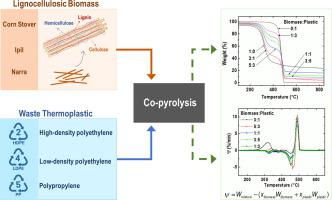Applied Energy ( IF 10.1 ) Pub Date : 2020-09-24 , DOI: 10.1016/j.apenergy.2020.115668 John Nikko V. Salvilla , Bjorn Ivan G. Ofrasio , Analiza P. Rollon , Ferdinand G. Manegdeg , Ralf Ruffel M. Abarca , Mark Daniel G. de Luna

|
Renewable lignocellulosic biomass is a promising energy resource since its co-pyrolysis with hydrogen-rich plastics can produce high-yield and high-quality bio-oil. In this study, co-pyrolysis of agricultural wastes (i.e. corn stover) and wood wastes (i.e. narra, Pterocarpus indicus and ipil, Intsia bijuga) with polyolefin plastics (i.e. polypropylene, low-density polyethylene, and high-density polyethylene) were examined via thermogravimetric analyses. Unlike previous co-pyrolysis studies which had focused on the improvement of product yield or cumulative weight loss, herein, we present the synergistic effects on the mass decomposition rate or rate of generation of products during co-pyrolysis. The main objective of this study is to evaluate the effects of temperature, and biomass-to-plastic ratio on rate synergy during co-pyrolysis. Rate synergy values up to 10% per min were obtained for biomass and plastic blends. Activation energy and pre-exponential factor of the reactions in the co-pyrolysis process were evaluated using the Coats-Redfern method. Activation energies for agricultural waste and plastics blends ranged from 45 to 82 kJ mol−1 while that for wood wastes and plastic blends ranged from 53 to 112 kJ mol−1. Interestingly, the activation energy of the thermal decomposition of plastic was found to be lower during co-pyrolysis with biomass than in pure form. Moreover, biomass-plastic co-pyrolysis followed a two-stage degradation: biomass degradation from 200 to 400 °C and thereafter plastic degradation from 400 to 500 °C. Overall, the use of lignocellulosic biomass and waste plastics for biofuel production can also minimize the volume of solid wastes for landfills.
中文翻译:

聚烯烃塑料与木材和农业废料的协同热解用于生物燃料生产
可再生木质纤维素生物质是一种有前途的能源,因为其与富氢塑料的共热解可产生高产量和高质量的生物油。在这项研究中,农业废料(即玉米秸秆)和木材废料(即纳拉,印度洋紫檀和伊皮尔,印度比久加)的共热解通过热重分析检查了使用聚烯烃塑料(即聚丙烯,低密度聚乙烯和高密度聚乙烯)的)。与以前的专注于提高产品收率或累积失重的共热解研究不同,本文中,我们提出了共热解过程中对质量分解速率或产物生成速率的协同作用。这项研究的主要目的是评估温度和生物质/塑料比对共热解过程中速率协同的影响。对于生物质和塑料混合物,获得了高达10%/分钟的速率协同效应值。使用Coats-Redfern方法评估了共热解过程中反应的活化能和指数前因子。农业废料和塑料混合物的活化能范围为45至82 kJ mol-1,而木材废料和塑料混合物的-1范围为53至112 kJ mol -1。有趣的是,发现在与生物质共热解过程中,塑料热分解的活化能要比纯形式低。此外,生物质-塑料共热解经历了两个阶段的降解:生物质从200-400°C降解,然后塑性降解从400-500°C。总体而言,将木质纤维素生物质和废塑料用于生物燃料生产还可以最大程度地减少垃圾填埋场的固体废物量。









































 京公网安备 11010802027423号
京公网安备 11010802027423号